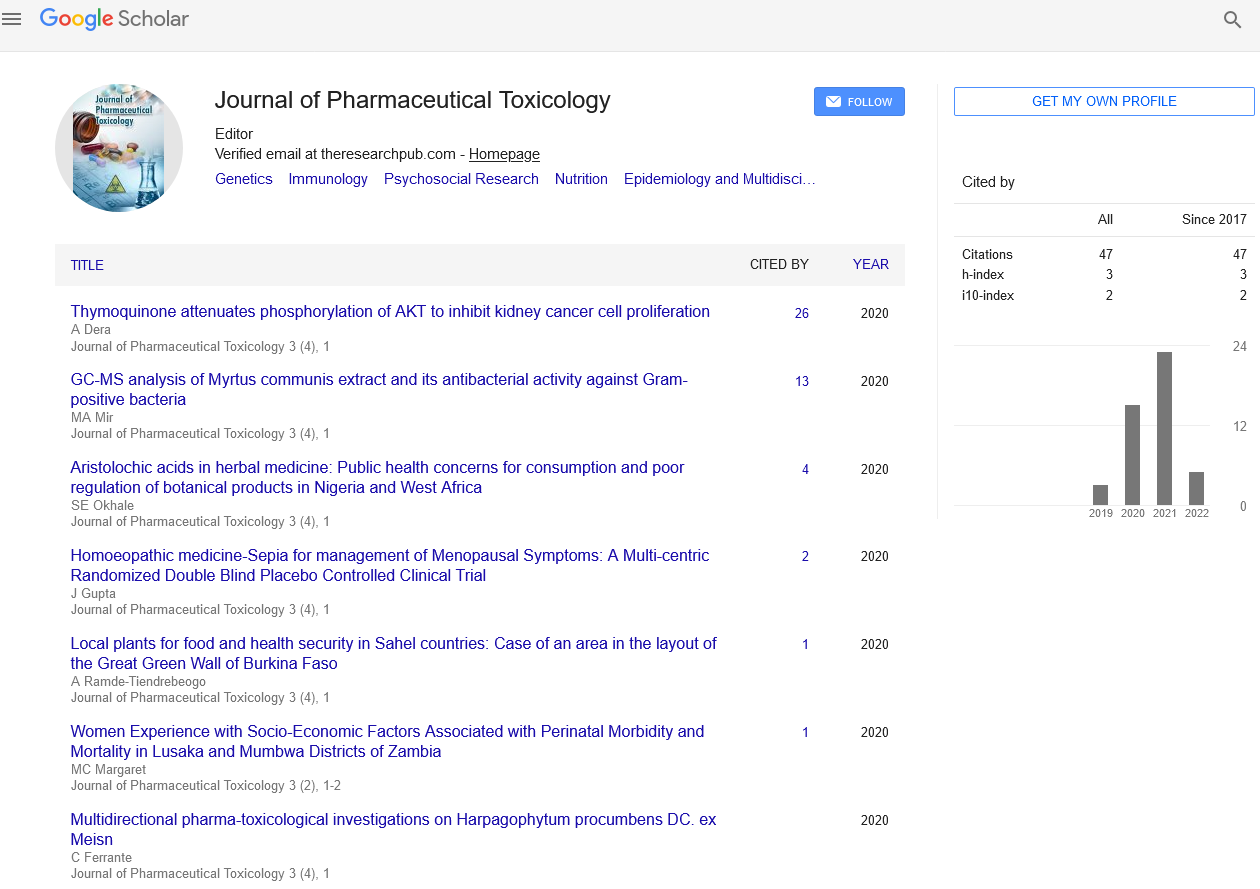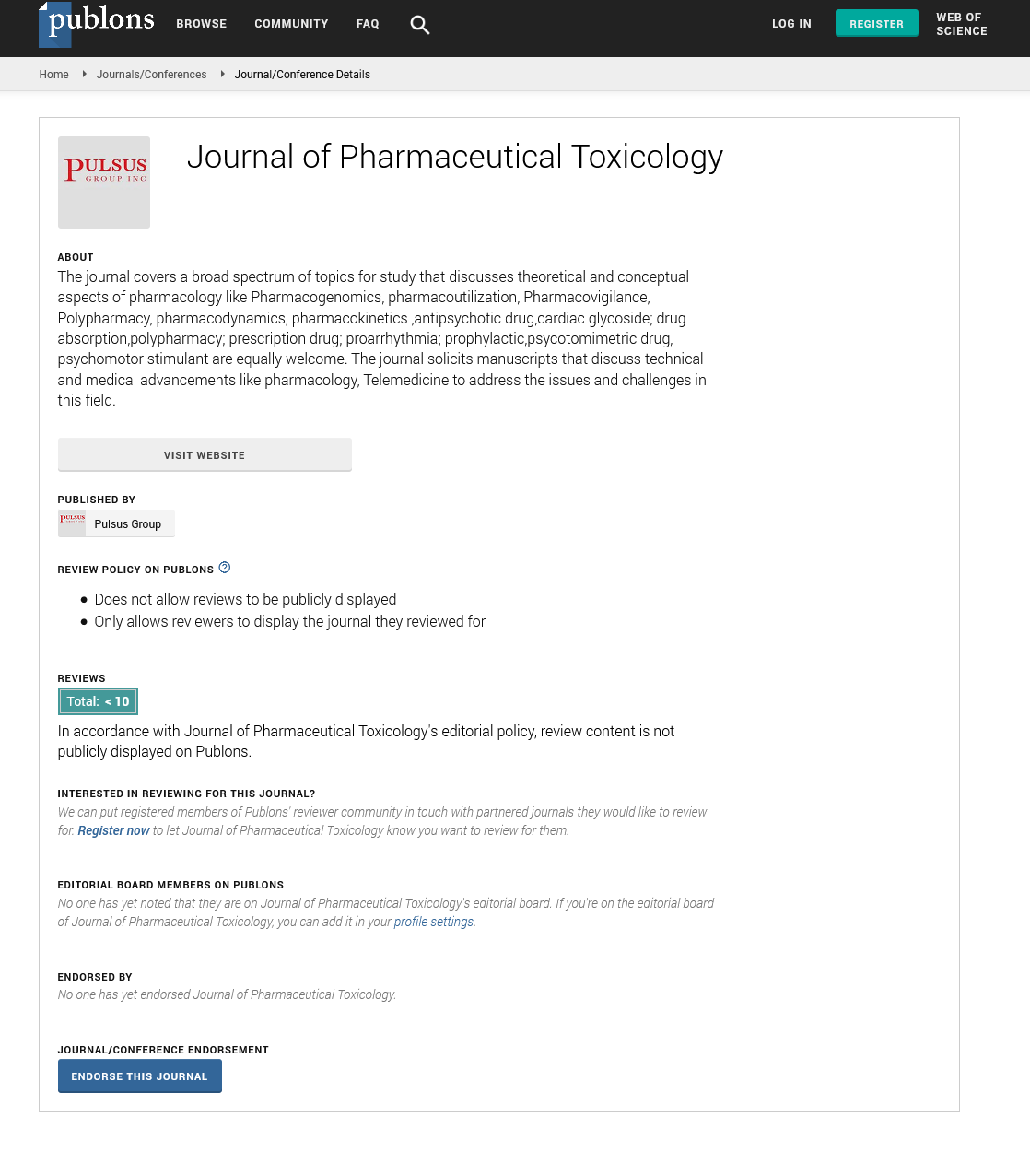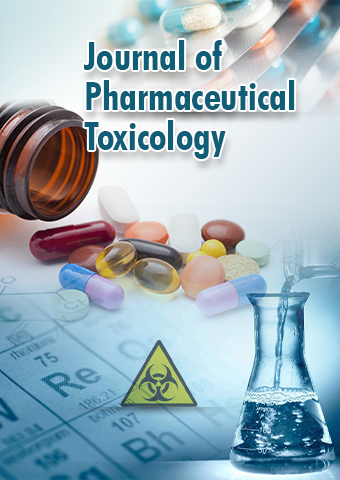Short Communication - Journal of Pharmaceutical Toxicology (2023) Volume 6, Issue 3
Advancements in Personalized Medicine: A Paradigm Shift in the Pharmaceutical Industry
Klaseen Shah*
School of Pharmacy and Bimolecular Sciences, Liverpool John Moores University, Byrom Street, Liverpool L3 3AF, UK
- *Corresponding Author:
- Klaseen Shah
School of Pharmacy and Bimolecular Sciences, Liverpool John Moores University, Byrom Street, Liverpool L3 3AF, UK
E-mail: klaseen12@gmail.com
Abstract
Introduction
The field of pharmaceuticals has witnessed a significant transformation in recent years with the advent of personalized medicine. Traditionally, medications were developed based on a onesize- fits-all approach, assuming that individuals would respond similarly to a given treatment. However, personalized medicine takes into account an individual’s unique genetic makeup, lifestyle factors, and medical history to tailor treatments that are specifically suited to their needs. This article explores the advancements in personalized medicine and the impact it has had on the pharmaceutical industry. Personalized medicine offers the potential to revolutionize healthcare by enabling targeted therapies that are more effective, safer, and have fewer adverse effects. By analyzing an individual’s genetic profile, physicians can identify genetic variations that may influence a person’s response to a particular drug.
This knowledge allows for the selection of medications that are most likely to be effective and avoids the use of drugs that may be ineffective or even harmful. The field of genomics has played a pivotal role in advancing personalized medicine. The ability to sequence an individual’s entire genome has become more accessible and affordable, providing valuable insights into the genetic factors underlying various diseases. Pharmacogenomics, a branch of genomics, focuses on studying how an individual’s genetic variations impact their response to drugs. This knowledge helps in predicting drug efficacy, dosage requirements, and potential adverse reactions [1-4].
Discussion
Personalized medicine has shown particular promise in the treatment of cancer. Through genetic profiling of tumor cells, oncologists can identify specific molecular targets and select targeted therapies that inhibit these targets. This approach, known as precision oncology, has led to improved treatment outcomes and reduced side effects compared to traditional chemotherapy regimens. The development of companion diagnostics has been another significant advancement in personalized medicine. These are diagnostic tests specifically designed to identify genetic markers or biomarkers that indicate whether a patient is likely to respond to a particular treatment. By using companion diagnostics, physicians can make more informed decisions about the most appropriate treatment for an individual patient.
Despite the progress made in personalized medicine, several challenges remain. The cost of genetic testing and sequencing, as well as the interpretation of complex genomic data, pose barriers to widespread implementation. Additionally, ethical and privacy concerns related to the handling of sensitive genetic information need to be addressed. However, ongoing research, technological advancements, and collaborations between academia, industry, and regulatory bodies are expected to address these challenges and drive the future of personalized medicine.
Personalized medicine represents a paradigm shift in the pharmaceutical industry, moving away from a one-size-fits-all approach to treatments and embracing individualized care. Through the integration of genomics, pharmacogenomics, and companion diagnostics, personalized medicine has the potential to improve patient outcomes, minimize adverse effects, and optimize healthcare resource allocation. As we continue to unravel the complexities of human biology and genetics, personalized medicine is likely to play an increasingly vital role in shaping the future of healthcare [5,6].
The field of pharmaceuticals has witnessed remarkable advancements in recent years, particularly in the area of targeted drug delivery systems. These innovative approaches have transformed the way medications are administered, resulting in improved efficacy, reduced side effects, and enhanced patient outcomes. By precisely targeting specific cells or tissues, pharmaceutical researchers have unlocked new possibilities for treating a wide range of diseases. This article explores some of the notable developments in targeted drug delivery systems and their impact on the pharmaceutical industry. Nanotechnology has emerged as a promising avenue for drug delivery. Scientists have been able to engineer nanoparticles with precise properties to encapsulate drugs and deliver them directly to the desired site in the body.
These nanoparticles can be functionalized with ligands that bind to specific receptors on target cells, enabling targeted delivery. Such advancements have revolutionized cancer treatment, allowing for the delivery of chemotherapy drugs directly to tumors while minimizing damage to healthy tissues. Antibodydrug conjugates (ADCs) combine the specificity of monoclonal antibodies with the potency of cytotoxic drugs. These molecules are designed to selectively bind to cancer cells, delivering a potent drug payload directly to the tumor site. ADCs have demonstrated remarkable success in the treatment of various cancers, including breast cancer and lymphomas. By improving drug localization and reducing systemic toxicity, ADCs have the potential to enhance patient outcomes and extend survival rates [7,8].
Liposomes are lipid-based vesicles that can encapsulate drugs within their aqueous core or lipid bilayers these versatile carriers offer several advantages, such as increased drug stability, controlled release, and targeted delivery. Liposomal formulations have been successfully utilized in the treatment of diseases like fungal infections and certain types of cancer. Ongoing research aims to optimize liposome design to improve drug loading capacity, enhance stability, and achieve site-specific release profiles. Implantable drug delivery systems provide a novel approach for long-term, controlled drug release. These devices can be surgically implanted in the body, delivering medications at a predetermined rate and duration. They are particularly useful for conditions requiring continuous drug administration, such as chronic pain management, diabetes, and hormone replacement therapy. Implantable devices offer convenience, improved patient compliance, and the potential for personalized medicine [9,10].
Conclusion
Targeted drug delivery systems represent a significant leap forward in the pharmaceutical industry, allowing for precise drug administration, improved therapeutic outcomes, and reduced side effects. The advancements discussed in this article, including nanotechnology, antibodydrug conjugates, liposomes, implantable devices, and gene therapy delivery, highlight the progress made in this field. As research continues and technologies evolve, targeted drug delivery systems are poised to reshape the future of pharmaceutical treatments, offering hope for more effective therapies across a broad spectrum of diseases. Gene therapy holds tremendous promise for treating genetic disorders and other diseases at the molecular level. Targeted delivery of therapeutic genes is critical for successful gene therapy outcomes. Researchers are exploring various delivery vectors, including viral vectors and non-viral vectors, to transport genes to specific cells or tissues. Advancements in gene delivery systems aim to overcome challenges related to immune response, off-target effects, and limited gene transfer efficiency.
Acknowledgement
None
Conflict of Interest
None
References
- Saraswat A. Topical corticosteroid use in children: Adverse effects and how to minimize them. Indian J Dermatol Venereol Leprol. 76, 225–228(2010).
- Beggs S. Paediatric analgesia. Aust Prescr. 31, 63–65(2008).
- Rossi M, Giorgi G. Domperidone and long QT syndrome. Curr Drug Saf, 5, 257–262 (2010).
- Kosek M, Bern C, Guerrant RL. The global burden of diarrhoeal disease, as estimated from studies published between 1992 and 2000. Bull World Health Organ. 81, 197–204(2003).
- Alam N, Najam R. Effect of repeated oral therapeutic doses of methylphenidate on food intake and growth rate in rats. Pak J Pharm Sci. 28, 9–13(2015).
- Ryan C, Ross S, Davey P et al. Prevalence and causes of prescribing errors: The PRescribing Outcomes for Trainee Doctors Engaged in Clinical Training (PROTECT) study. PLoS ONE. 9, 69-143(2006).
- Patrick DM, Marra F, Hutchinson J et al. Per capita antibiotic consumption: How does a North American jurisdiction compare with Europe? Clin Infect Dis. 39, 11-17 (2004).
- Li WC. Occurrence, sources, and fate of pharmaceuticals in aquatic environment and soil. Environ. Pollute. 187, 193-201 (2014).
- Heberer T. Occurrence, fate, and removal of pharmaceutical residues in the aquatic environment:A review of recent research data. Toxicol Lett. 131, 5-17 (2002).
- Banci L, Ciofi-Baffoni S, Tien M Lignin et al. Peroxidase-catalyzed oxidation of phenolic lignin oligomers. Biochemistry. 38, 3205-3210 (1999).
- Berthe-Aucejo A, Nguyen PKH, Angoulvant F et al. Retrospective study of irrational prescribing in French paediatric hospital: Prevalence of inappropriate prescription detected by Pediatrics: Omission of Prescription and Inappropriate prescription (POPI) in the emergency unit and in the ambulatory setting. BMJ Open. 9, 45-66(2015).
- Al Balushi KA, Al-Sawafi F, Al-Ghafri F et al. Drug utilization pattern in an Omani pediatric population. J. Basic Clin Pharm. 4, 68–72(2014).
- Al-Badri A. Almuqbali J, Al-Rahbi K et al. A Study of the Paediatric Prescriptions at the Tertiary Care Hospital in Oman. J Pharmaceut Res. 5, 17-56(2020)
- Al-Maqbali, Haridass S, Hassali M et al. Analysis of Pediatric Outpatient Prescriptions in a Polyclinic of Oman. Glob. J Med Res. 19, 2249–4618(2019).
- Bakaki PM, Horace A, Dawson N et al. Defining pediatric polypharmacy: A scoping review. PLoS ONE , 13, 56-99(2018).
- Lemeshow S, Hosmer DW. A review of goodness of fit statistics for use in the development of logistic regression models. Am J Epidemiol. 115, 92–106(1982).
- Wallace E, McDowell R, Bennett K et al. Impact of Potentially Inappropriate Prescribing on Adverse Drug Events, Health Related Quality of Life and Emergency Hospital Attendance in Older People Attending General Practice: A Prospective Cohort Study. J Gerontol A Biol Sci Med Sci. 72, 271–277(2017)
- Cahir C, Moriarty F, Teljeur C et al. Potentially inappropriate prescribing and vulnerability and hospitalization in older community-dwelling patients. Ann Pharmacother. 48, 1546–1554(2018).
- Cullinan S, O’Mahony D, Fleming A et al. A meta-synthesis of potentially inappropriate prescribing in older patients. Drugs Aging.31, 631–638(2014).
- Liew TM, Lee CS, Goh Shawn KL et al. Potentially Inappropriate Prescribing Among Older Persons: A Meta-Analysis of Observational Studies. Ann Fam Med. 17, 257–266(2019).
Indexed at, Google Scholar, Cross ref
Indexed at, Google Scholar, Cross ref
Indexed at, Google Scholar, Crossref
Indexed at, Google Scholar, Crossref
Indexed at, Google Scholar, Crossref
Indexed at, Google Scholar, Crossref
Indexed at, Google Scholar, Cross ref
Indexed at, Google Scholar, Cross ref
Indexed at, Google Scholar, Cross ref
Indexed at, Google Scholar, Cross ref
Indexed at, Google Scholar, Cross ref
Indexed at, Google Scholar, Cross ref


